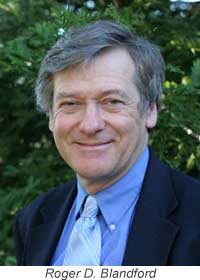2016 Crafoord Prize Goes to Roy Kerr & Roger Blandford

Richard Fienberg Running Hare Observatory
This announcement is adapted from a press release from the Royal Swedish Academy of Sciences:
The Royal Swedish Academy of Sciences has decided to award the 2016 Crafoord Prize in Astronomy to Roy Kerr (University of Canterbury, New Zealand) and Roger Blandford (Stanford University) "for fundamental work on rotating black holes and their astrophysical consequences." Blandford is an AAS member and served as a Councilor from 1999 to 2002; in 1998 he received the Dannie Heineman Prize for Astrophysics from the American Institute of Physics and the AAS.
Black holes are the source of the universe's most powerful radiation, as well as jets that can stretch many thousands of light-years out into space. Roger Blandford's theoretical work deals with the violent processes behind these phenomena. Roy Kerr laid the foundation for this research early on, when he discovered a mathematical description of rotating black holes. This became one of the most important theoretical discoveries in modern cosmology.
The prediction of black holes is one of the perhaps strangest results of the general theory of relativity. When Albert Einstein finally presented his theory in November 1915, he described gravity as a geometric property of space and time, spacetime. All objects with mass bend spacetime; they create a pit into which smaller objects can fall. The greater the mass, the deeper the pit. The mass of a black hole is so great that nothing that ends up in there can escape, not even light.
It was not until 1963 that mathematician Roy Kerr succeeded in solving Einstein's equations for rotating black holes. That the holes should rotate is feasible because the stars from which they originated should have rotated. At about the same time, astronomers discovered galaxies that emitted light and other electromagnetic radiation that was so strong it outshone several hundred ordinary galaxies. They were named quasars. Nothing other than a black hole could give the quasars their luminosity.So how is the strong light of rotating black holes created? This question was answered by Roger Blandford and his colleagues in the 1970s. Ever since, he has refined and made more realistic models of how gas surrounding a black hole flows towards it, is heated up, and transforms some of its gravitational energy to radiation. While this is happening, electrically charged particles are sent millions of kilometers into space in the form of powerful jets. The source of all of this power is the rotational energy of the massive black hole.
The 6 million Swedish krona (approximately $700,000) Crafoord Prize in Astronomy will be shared equally between the laureates. The prize award ceremony is to be held at the Royal Swedish Academy of Sciences on 26 May 2016 in the presence of Their Majesties the King and Queen of Sweden.



